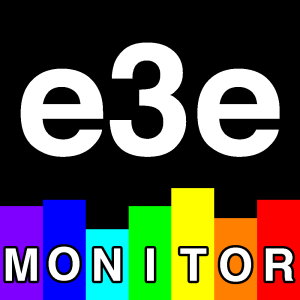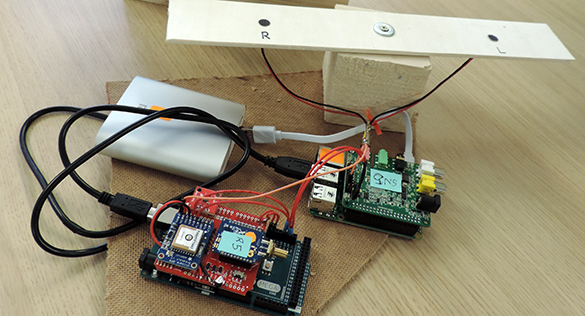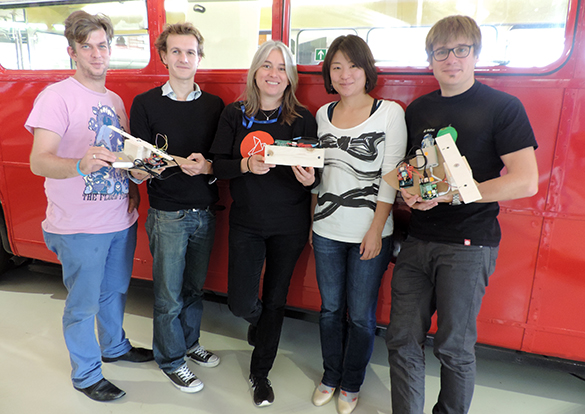Believe me….. This is beautiful stuff! It may not have great aesthetic appeal. It may not represent your idea of “art.” It may not be what you expect to find on talkingbeautifulstuff.com but this is the output of the creative thinking of some brilliant young scientists. It will, without doubt, prove to be a world-changer. A feel-good story, albeit about awful stuff, and you first read about it here!
This is the prototype of a system whereby explosions and other extreme energy events (e3e) can be detected in real-time and geo-located. The “R” and “L” black dots on the board are microphones that detect the position of any explosion or gunshot within 2-3 km. The sound signals are analysed for the unique “acoustic signature” of the explosion, triangulated with those picked up by other detectors and ultimately fed onto a publicly accessible, web-based map.
The detectors are made from commercially available materials and – with it’s own battery pack – can be fitted into something not much bigger than a brick.
The raison d’etre…… The use of explosives especially in urban areas defined the history of the last century. Will this century be free of the extraordinary human propensity to blow up places where other humans live and work? The daily news is not encouraging. In terms of the nature and extent of the destruction, the reporting of such events still remains in the domain of eye witness accounts and official statements. The e3e detector system would permit monitoring – on an entirely objective basis – of explosions and other extreme energy events in a given context. The watching world would have rapid alert and hard, scientific evidence to compare with verbal reports, claims and counter-claims. Consider this: A town is caught up in conflict. The e3e detectors are in place and ready to transmit data to the website. There is an explosion at a hospital. The system would immediately indicate the time, precise location and the likely weapon. Importantly, it would also indicate whether or not there were shots being fired from the hospital beforehand as is so often claimed.
Here are just some of the scientists who are applying their considerable brain power to the technological aspects of monitoring explosions and other extreme events. (Yes, that is an old London Transport double-decker bus in the background.)
CERN (the European Centre for Nuclear Research) is a huge international scientific collaboration straddling the French-Swiss border. It is best known for its research based on the Large Hadron Collider. Not so well known is that research in other fields at CERN gave us wonderful things such as the world-wide web, touchscreens and the means to capture solar energy. A number of scientists there want to continue this tradition of pursuing technologies that will positively impact human lives in decades to come. Enter THE Port. This month saw THE Port’s second hackathon in CERN’s Idea Square (in which an old London Transport double-decker bus serves as just one of the interesting discussion spaces.) This event brought together young scientists from all over the world for three days of challenge-based innovation. One of the chosen challenges was to build the e3e prototype and demonstrate its real-time link to a website. They did it! Take a look at the final video presentation.
These guys do not lack forward thinking. They imagine a global network of detectors that can be deployed by any interested party. The detectors could even be assembled by anyone anywhere with the right instructions and access to the materials; hence the importance of using commercially available parts. They also foresee automated monitoring of Twitter activity within a certain distance of and triggered by an explosive event. This would serve to verify the event and give more information regarding the evolution of the context especially the human impact. Just digest the implications!
It’s time for the crunch questions: Who would the end-users be? How would e3e Monitor bring about change? Here are the answers from the team:
- Peace-keeping / enforcing bodies could reliably monitor conflicts and cease-fire agreements.
- Humanitarian / relief organisations would be able to use the information to assess damage, their own operational security and the needs of affected civilians.
- The media would have a more accurate and non-biased picture of events relying less on “reports.”
- An affected population would have access to better information about what is happening and where and so be able to make their own security decisions if, for example, they are moving from one town to another.
- Airlines would be able to verify areas of active conflict and so change flight schedules, flight paths and assess security of airports.
- Lawyers would be able to use the information as “evidence“ in the pursuit of prosecuting war crimes.
- Academic organisations including those orientated around conflict and peace-building could use the information for a wide variety of research projects.
- With a view to the long term, e3e Monitor technology and networks should become part of the essential infrastructure of any urban environment.
 The team has even designed a logo. I love the subliminals: scientific detection and monitoring of a spectrum of explosions and extreme energy events together with black box data storage. If explosions in populated areas is your concern, this is a logo you’ll be seeing in the future.
The team has even designed a logo. I love the subliminals: scientific detection and monitoring of a spectrum of explosions and extreme energy events together with black box data storage. If explosions in populated areas is your concern, this is a logo you’ll be seeing in the future.



